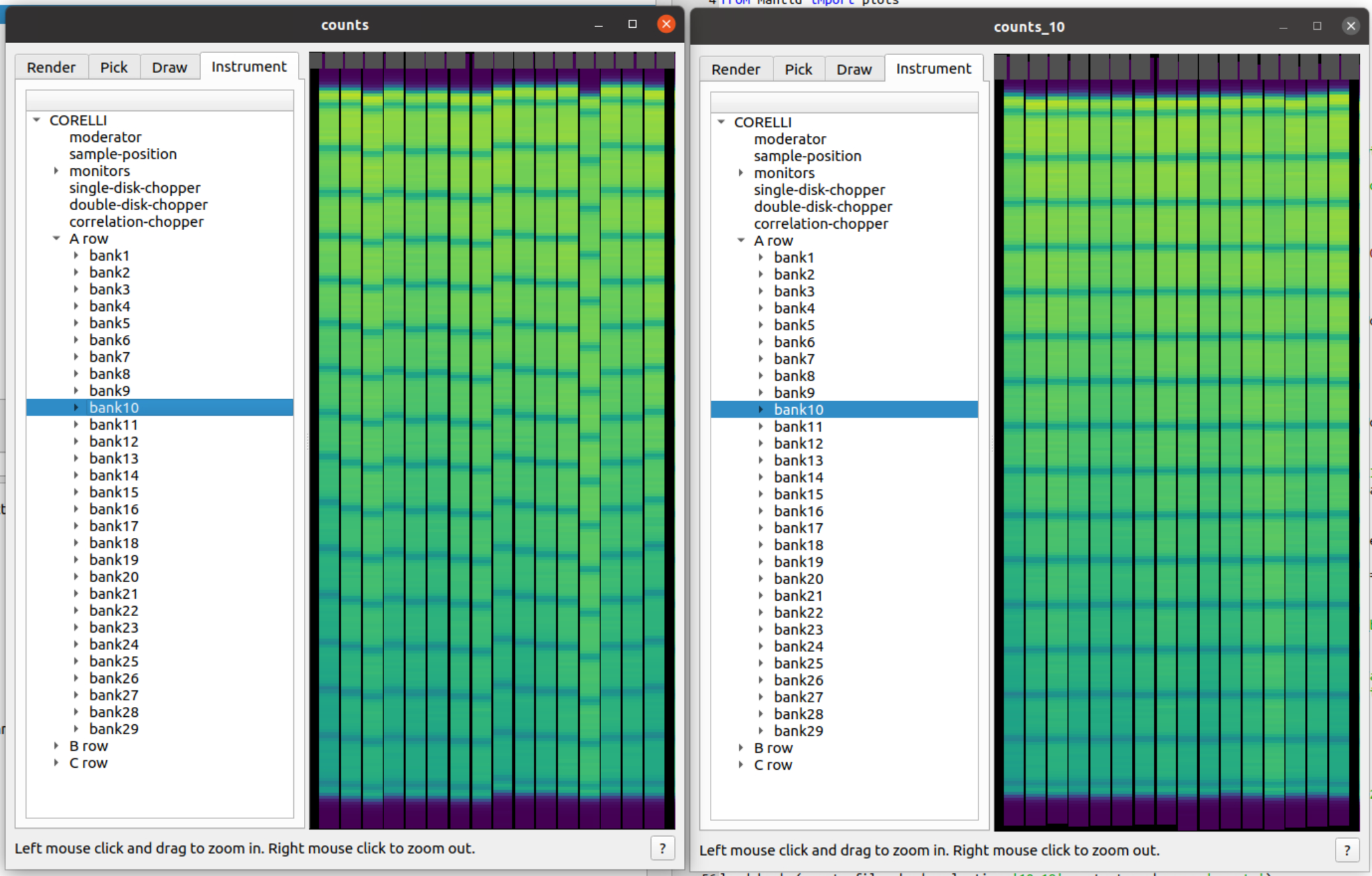Corelli Tube Calibration¶
Introduction¶
Mantid has specific functionality for the Corelli instrument at Oak Ridge National Laboratory (ORNL). The Python scripts are located at: **MANTIDINSTALL**/scripts/corelli/calibration (github link).
These scripts can be launched on MantidWorkbench.
The overarching goal is to create and update the information from the applied calibration functions as new cycles are performed. The result is a database of calibrated vertical “Y”-coordinates stored for each bank as a Table Workspaces with pixel_id and Y-coordinate columns.
Performing a Calibration¶
The following example illustrates the steps to follow for bank calibration.
Load counts from instrument file
Select banks to be calibrated
Apply the calibration algorithm from
corelli.calibration.utils
from corelli.calibration.bank import calibrate_banks
from corelli.calibration.utils import apply_calibration, load_banks
counts_file = '/SNS/CORELLI/shared/tmp/CORELLI_124023_counts.nxs'
load_banks(counts_file, bank_selection='10-19', output_workspace='counts')
calibrate_banks('counts', bank_selection='10-19')
apply_calibration('counts', 'calib10', output_workspace='counts_10')
Open the instrument view for workspaces counts and counts_10, then look at bank10 and verify that all tubes in this bank have been calibrated for counts_10

Calibration Database¶
Calibrated banks can then be stored in a database which follows the current structure:
database_path/
manifest_corelli_20201201.csv
manifest_corelli_20210601.csv
bank001/
calibration_corelli_bank001_20201201.nxs.h5
mask_corelli_bank001_20201201.nxs.h5
fit_corelli_bank001_20201201.nxs.h5
calibration_corelli_bank001_20210601.nxs.h5
mask_corelli_bank001_20210601.nxs.h5
fit_corelli_bank001_20210601.nxs.h5
bank002/
bank003/
Each bank subdirectory contains 3 binary NeXus HDF5 files per calibration cycle (identified by the date timestamp) corresponding to a workspace that be loaded directly on MantidWorkbench for:
calibration: correctly calibrated pixel_id and Y-coordinates
mask: flagged pixel_id that didn’t pass calibration criteria
fit: summary
Each calibration cycle generates a manifest file in csv format. It contains information on the bank_id and timestamp for the performed calibration.
Manipulation of the database, in particular saving and loading the files to/from Mantid workspace is provided in the database.py module
The user should only be dealing with the following functions when saving/loading calibrations. Any other functions should only be used for debugging purposes.
bank/load_banks
bank/calibrate_banks
database/save_calibration_set
database/new_corelli_calibration
database/load_calibration_set
As an example we can use:
from corelli.calibration.database import save_calibration_set, load_bank_table, load_calibration_set
from corelli.calibration.bank import calibrate_banks
# populate a calibration database with a few cases. There should be at least one bank with two calibrations
database_path = '/SNS/CORELLI/shared/calibration_database'
ws = [('124023_banks_14_15', [ws14,ws15])]
cases = [('124023_banks_14_15', '14-15')]
# use current date if not provided
save_manifest_file(database_path, [14, 15])
for bank_case, bank_selection in cases:
# Produce workspace groups 'calibrations', 'masks', 'fits'
# ws is a dictionary with workspace values
calibrate_banks(ws[bank_case], bank_selection)
save_calibration_set(ws[bank_case], database.name, 'calibrations', masks, 'fits')
# Each bank calibration table can be loaded for a particular timestamp date:
# Not required, but good for debugging
load_bank_table(14, database_path, date)
load_bank_table(15, database_path, date)
# Or just the set
load_calibration_set(self.cases['124023_bank10'], database_path)
Category: Calibration